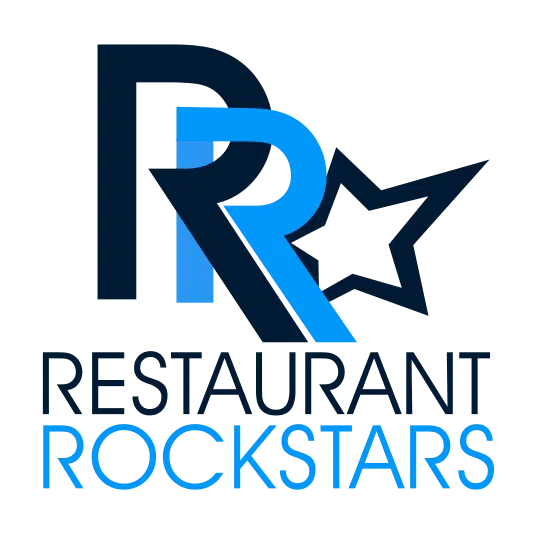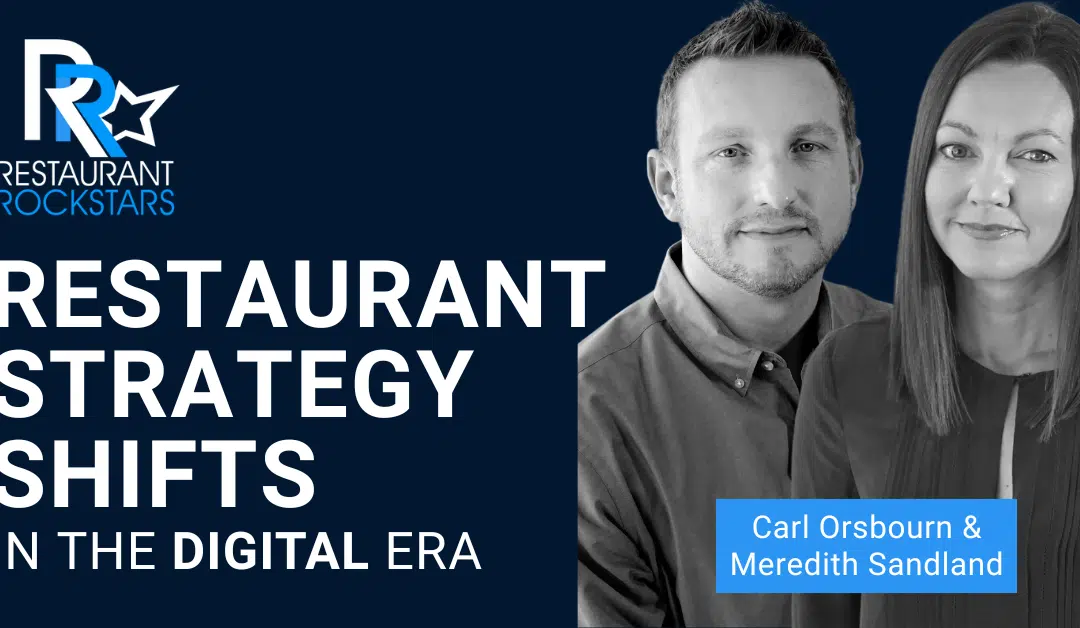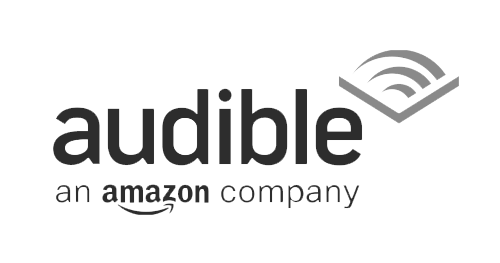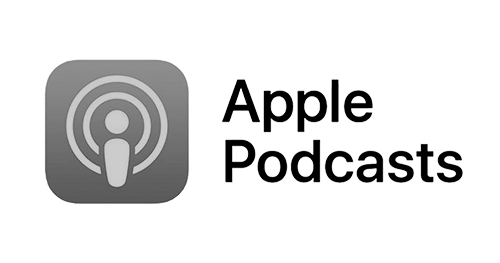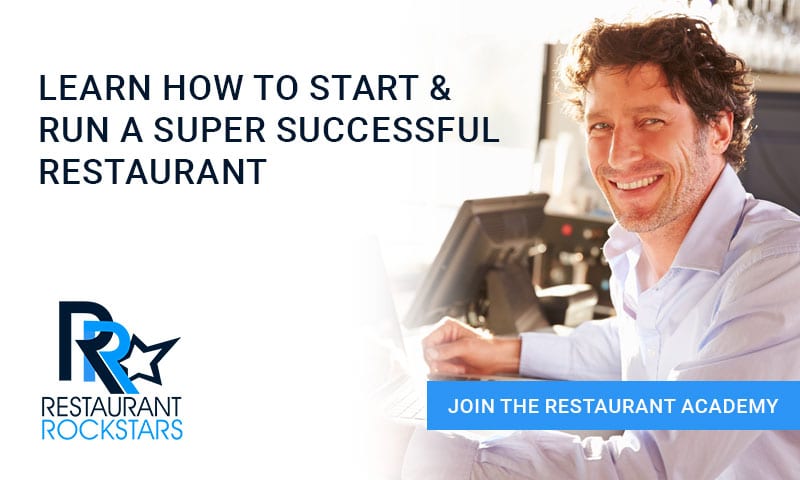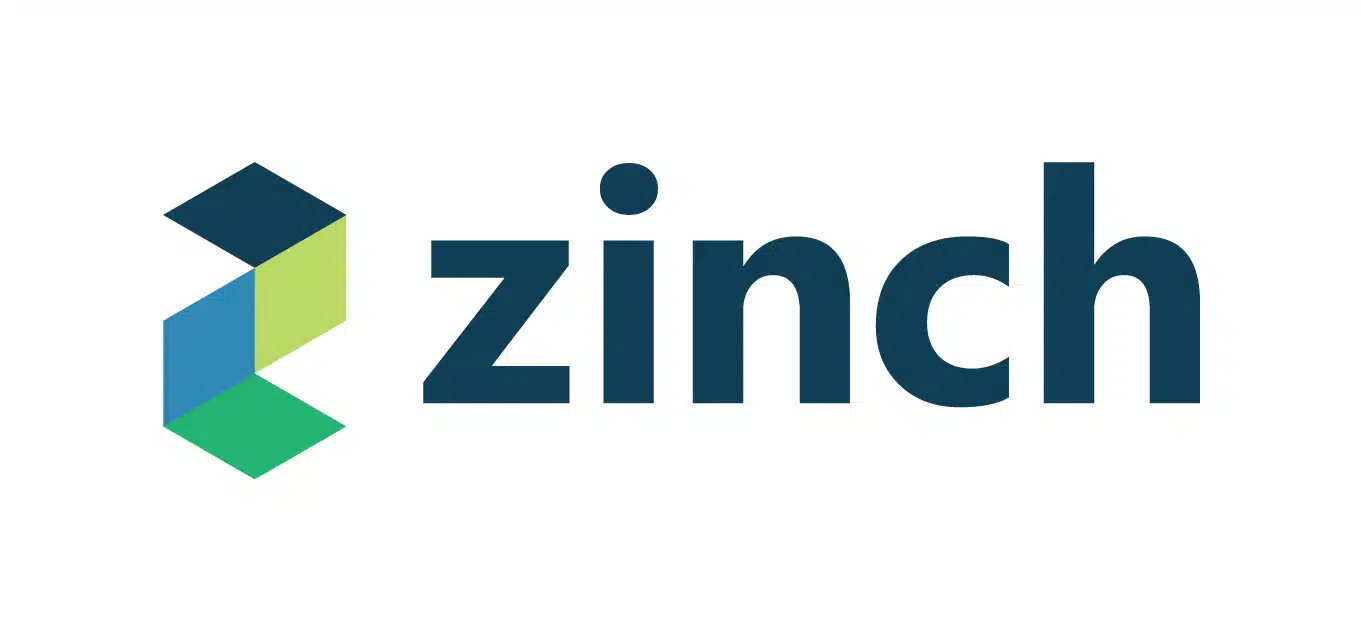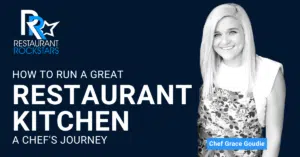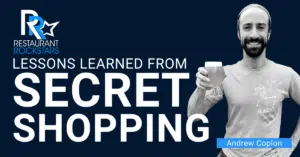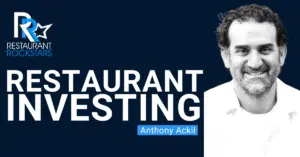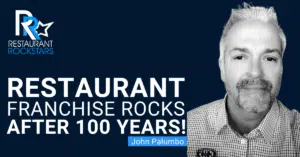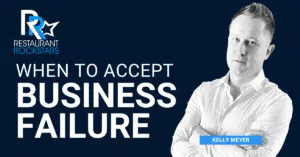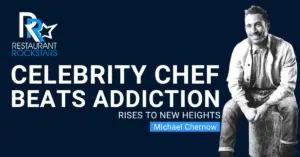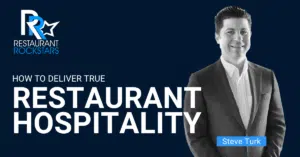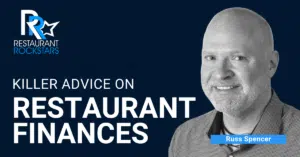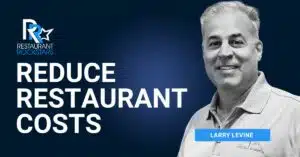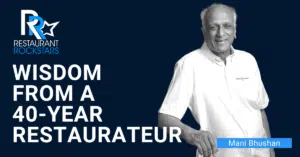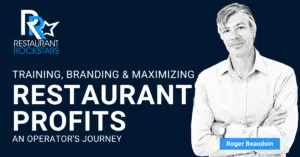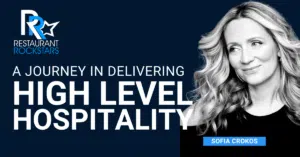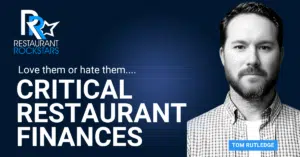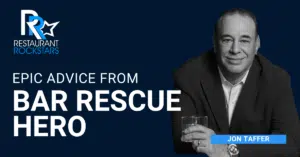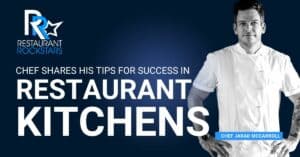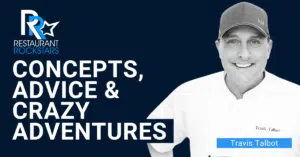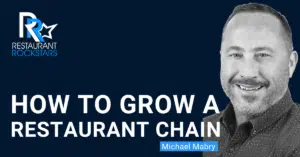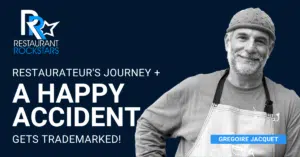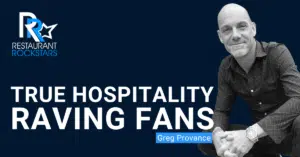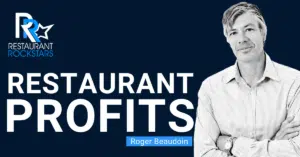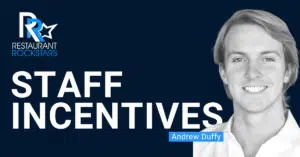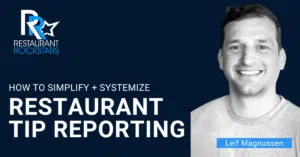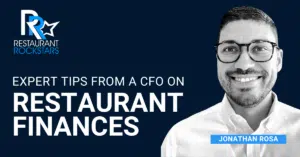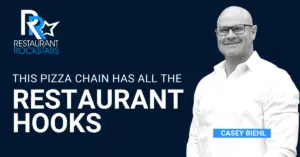Restaurant Rockstars Episode 337
Restaurant Strategy Shifts In The Digital Era
LISTEN HERE OR ON YOUR FAVORITE PODCAST PLAYER
Prefer to watch the interview?
Click the video below.
I coach my clients all the time to stop running a restaurant and start running a business.
You can either have a restaurant strategy or keep putting out daily fires. Having a strategy is pro-active and moves your business forward.
In this week’s episode of the podcast, I am speaking with restaurant strategy experts Carl Orsbourn and Meredith Sandland.
Listen as Carl and Meredith coach us on:
- What many operators are missing in their restaurant strategy
- A new approach to your business post-pandemic
- Building on pivots restaurants have had to execute.
- Being a pro-active strategist not a firefighter
- Necessary technology for your restaurant today
- The ins and outs of 3rd party delivery
- Is a ghost kitchen right for your operation?
And of course, we speak about Carl and Meredith’s second book “Delivering the Digital Restaurant, The Path to Digital Maturity”. This book gives you the how-to roadmap to execute a digital restaurant strategy in your operation.
Listen, get inspired and then go out and Rock YOUR Restaurant!
Roger
Connect with our guest:
-
- YouTube @thedigital.restaurant
- TikTok @thedigitalrestaurant
- Facebook @DeliveringtheDigitalRestaurant
- Instagram @TheDigital.Restaurant
- Twitter @LearnDelivery
- Linked In @DeliveringtheDigitalRestaurant
0:00
the restaurant industry is going last right? We are one of the last industries to digitize. And so we can look around and see what happened in travel, what happened in retail and think about how we want it to happen in restaurants to change your mindset to think not how do I slap some technology on top of what I’m already doing? But how do I use technology to fundamentally change how I’m showing up in the world? How I’m operating, I’ll engage with my employees, everything.
0:30
Welcome back to the restaurant rockstars podcast. Thanks so much for joining me. Once again. The pandemic really shifted the way all of us had to run our business. You know, the numerous pivots have forced most of us not only in how we operated then But moving forward with our business to adopt new technologies that would make our business more efficient to bring in new sources of sales and profit. With me today are Carl Osbourn and Meredith Sandland. And they’re repeat guests and two time authors will talk all about their books that not only give you the strategy of how to make your business more efficient in a digital world, but also the How to roadmap to move your business down the road with technology. But mostly this episode is about how you as an operator can be more of a strategize er, versus a firefighter. You know, the unexpected is always around the next corner. A lot of operators are just putting out the daily fires, but we really need to plan ahead and be strategic about how we run our business. Thanks to the sponsors of this week’s episode Whirks, Smithfield Culinary, Zinch and The Restaurant Academy. Now with the academy, you can train your staff you can assign different modules in finance, in marketing, in staff training, and really move your business forward as well. That’s called an exit strategy. So check that out at restaurantrockstars.com. Now, on with the episode,
1:56
you’re tuned in to the restaurant rockstars podcast powerful ideas to rock your restaurant. Here’s your host Roger Beaudoin.
2:06
At Smithfield, they know that to meat lovers, a great serving of their favorite cut is so much more than just food. It’s an experience, one that keeps them coming back to your operation again and again. They’re committed to offering you the perfect protein for every dish at each day part. Turn to Smithfield for the most comprehensive portfolio of pork products, such as bacon, ham, sausage, and more. Plus a variety of fully cooked beef and chicken. With Smithfield products, you can create delicious meals from traditional menu items to globally inspired dishes, all designed to satisfy the insatiable appetites of your hungry carnivorous patrons. What’s more, Smithfield does it responsibly with full transparency and traceability from their farms to your kitchen. You can always be confident that when you partner with Smithfield, you will serve what you love, and your customers will love what you serve. Find your perfect protein with Smithfield. For more information or to order products visit Smithfieldculinary.com/smithfield
3:17
Restaurateurs and GMs, unexpected expenses are always around the corner, broken equipment overhead during slow times, even new ideas to improve your business and you need cash fast. Well, let me tell you about Zinch. A direct lender that makes financing fast and simple around your restaurant needs. If your restaurant is doing over $10,000 in monthly revenue, and in business, over six months, since you can fund up to $250,000 in less than two days. Just fill out a simple online application and provide a copy of your four most recent bank statements. And you can get an approval within 24 hours. See how much cash you can get with Zinch. And right now my listeners can apply without fees. That’s a $250 value. Go straight to financingthatworks.com. Again, that’s financingthatworks.com loans made arranged pursuant to a California finance lenders law license.
4:16
Hey there, and welcome back to the restaurant rockstars podcast, engaging topics that help restaurants build their brands, rock their profits and deliver amazing guest service experiences. Welcome back to the show, Carl and Meredith, you’re with me about a year and a couple of months ago and I’m glad to have you back. How are you guys doing? Well, thank you. Good to be back.
4:36
Well, it’s always interesting. I love having multiple guests because it offers a different perspective on different topics. You guys are both in a position to answer any of these questions, but you’ll have to decide who speaks when and who answers what question but let’s start. Ladies first Meredith let’s let’s get back into your career trajectory and your hospitality backstory. When did it all begin for you? just kind of take us along your career since you first, you know, got involved in the hospitality space.
5:05
Yeah, well, I got into restaurants by accident, as I think almost everybody does, that fell in love with it very quickly. My accident was that I interviewed with man named Greg, who was then the CEO of Taco Bell, subsequently of Yum. And a woman named Melissa Laura, who was a CFO, and thought they were such amazing people that I wanted to work for them and see how they did what they did. And once I was at Taco Bell then fell in love with the hospitality industry and restaurants and the business of restaurants and how just a miracle it is that they make consumers so happy and some such an important need, but also make money at the same time. It’s incredible. So I was the chief development officer, talk about lots and lots to talk about about halfway through that journey thought, why are we putting them next to malls when no one goes to malls anymore? And it planted a seed in my mind that only grew when we tried to enter Manhattan. And I thought, why are we paying the world’s most expensive real estate when 40% of sales are going out the door delivery. And between those two things. When I met the guys at kitchen united, I thought, oh my gosh, they’re making what I asked the customer, the chief development officer of a big national brand wish existed, which is a ghost kitchen or commissary that I can just serve tacos delivery out of. And that’s how I ended up in this innovative part of the restaurant industry. And that’s also where my story intersects with Carl’s.
6:46
That’s a great story. Tell us a little bit more about yum brands. Obviously, it’s one of the largest restaurant groups and they represent multiple brands and concepts. What are some of those? You mentioned extensively about Taco Bell. But let’s talk a little bit about the yum brand brands.
7:03
Yeah, so Yum, of course, Taco Bell, they own KFC, which is their largest brand around the world. And then they own Pizza Hut. Which actually, pizza I believe is one of the original ghost kitchens. So they’re a little dako units are very, very similar to because kitchen. And then recently they bought the habit, which is a hamburger drive thru chain kind of higher end hamburgers out here based in California.
7:33
How many locations in all of all those concepts does yum control right now?
7:39
Oh, my goodness. Probably up to 50 or 60,000? Yeah, it’s the largest restaurant company in the world. It’s amazing. And they’ve really systematize the business of restaurants, which is incredible.
7:57
So Carl, how about you tell us about your hospitality backstory. And Meredith started saying something about in the here’s where our sort of lives and careers intersected. So tell us about that. And you can sort of finish that sentence once you tell us about your backstory.
8:11
Yeah, so obviously, Meredith and I miss each other teaching united. But probably the the similarity between both of us was that we were coming from huge organizations into a startup environment. In fact, when I first met Meredith, I wasn’t meeting her to discuss kitchen united, I was meeting her to discuss what’s it like to leave a big company and go into a startup environment. I hadn’t heard of ghost kitchens. Honestly, before Roger, my background is multi unit retail. I spent 15 years in the in the convenience retail industry culminated in me running 1000 units business over here on the West Coast of the US by the name of AMPM. That did over a billion dollars worth of revenue alone, you know, nothing to do with the gasoline side of the business. Right, about 30 40% of that was coming through food products. And I’d seen even at that stage, just the way in which the consumer that was visiting see stores had a greater thirst for even greater levels of convenience. There’s a small little company out there you should google called Amazon. And for me, they’re the they’re the ultimate C store retailer, right? Because in many ways, they can get you whatever you want, whenever you want it, and you don’t even have to leave your your home. So I was seeing a lot of trends happening on that. Also an electrification which Meredith know that we’ll talk to you later in terms of kitchen setup, but I was more seeing it from logistics and the way in which people were getting more and more comfortable to have food and other items brought to them. And so I wanted to get more into an entrepreneurial type of world and so Meredith and I met up after a mutual friend introduced us and she told me about this thing called Ghost kitchens that she had got involved in. And I was like, Okay, well, you know, she She must know a thing. I’d say she was the CTO at Taco Bell, but the ghost kitchens Poor thing, what on earth is she on about. And obviously, I was very, very intrigued when I learned more about the term ghost kitchen. Because as Meredith has just told you, it makes so much sense that actually now if you can actually develop units that can produce the food closer to where the end consumer is, and do that in a way that is capitally light and do it in such a way that allows you to help restaurants get access. This sounds like a very compelling proposition. And so, lo and behold, within I don’t know, it was a month or two, Meredith we started working with each other I was responsible for developing the kind of operating setup within kitchen United thinking about how we’re going to scale the the concept. And it was great because both Meredith and I had met every or pretty much every big restaurant chain executive across the US, who at that time, of course, was perhaps curious, perhaps, you know, unsure about what ghost kitchens were, whether it fits into their strategy, and the digital disruption that was occurring in our industry was only just starting to gather steam. This was all of course, pre pandemic. And so I remember speaking to folks, our sales team will be speaking to folks. And I would say to Meredith, they’re still not getting it, there’s still some begrudging feel as to whether this is the direction they should go with them. I’d love to get each of our current clients and some of the prospects a book that can be an impartial accounts, on why they should take this seriously, why this isn’t, you know, the VCs or the tech companies that are driving this change. And meredith said, in a matter of fact, yeah, great, go, go get it, that’s fine. No problem. And so I spent about 20-30 seconds on Amazon looking for said book. And the book wasn’t there, I searched three, four pages didn’t exist. And that really is the Genesis story for our first book, that really was the point in time where we said, Hmm, what happens when something doesn’t exist, why you go and create it. And so after we both left kitchen united, we set our hearts on trying to get something out to the industry, which we thought was very necessary at that stage. And it was really at that point, when the outline was written, I think we’d already started writing the book. And there was something happening in Wuhan, China that caught our attention. And then of course, before you know it, we’re into the midst of a pandemic. And every restaurant in the US became a ghost kitchen, or at least had to certainly turn their attention firmly into digitization to preserve their long term future. And so our pens had to move a little faster, or suddenly, our fingers on the keyboard had to move a little quicker. And we got the book out, firstly, in Kindle in July of 21. And then the hardback came out in October of 2021. Delivering the digital restaurant, your roadmap to the future of food, our first book was a phenomenal success far better than we ever could have imagined. I became a best seller, not just here in the US, but in another number of countries. It’s just got translated into Romanian Would you believe the restaurant. And really, it was because so many restaurants, not just here in the US, but around the world really needed something to help them see what was happening. And when we tell the story, and we tell the story through 100 or so executives in the restaurant and tech space and their journey towards today. And it’s really about helping the the independent restaurant owner operator as well as the chain executives, as well as perhaps those that are supporting the wider system. Try and understand why is this happening and why you should take it seriously. That was that was our objective back then.
13:41
You know, you’re bringing up so many interesting points, both of you. So now that we’re focused on this sort of transition, there are so many different types of operators out there, there are those that are, you know, very progressive tech savvy operators that are running larger restaurant groups. And then you’ve got a lot of old school independent operators that are still running by the seat of their pants, and the pandemic has forced them to pivot numerous ways and sort of look into future technologies to help them run smarter, more efficient businesses, but a lot of them are stuck. So when you say this is a roadmap, if if an independent operator picked up your first book and read it through, it would obviously inspire them. But would it provide a how and why and where and what to actually help them move the business forward?
14:29
It would not. Yeah, that’s exactly why we wrote the second book, but that first book was really more. Why is this happening? Why do you need to take it seriously, what exactly is happening, who’s doing it? Which I think was important and useful and helped push the industry forward in terms of changing mindset. But it isn’t practical How-to, first do this, don’t do that. And it’s so many of the questions we’ve gotten in the last year and a half. Well, we’ve been you know, out on the road speaking to restaurants have been around. Okay, I get it. It’s important, but I hate the third parties. Why do I have to use them? So there’s a whole chapter on why you have to use them and maximizing them and using them? Well, I get it, I need to have a first party ordering system. But I mean, can’t I just slap anything up on the internet and call it a day? My real focus is dine in? Well, no, you have to make it great. And here’s what great means. And once it is great, here’s how you get people to use it. Right. So it’s, it is a much more practical book, the path to digital maturity gives restaurants I think, a more specific how to and, you know, one of the one of the things you raise with there, there is a sort of tale of two cities in the restaurant industry. There’s giant chains with huge headquarters, and they have teams of 50 to 100 technology, people sitting around dreaming up how things should work and putting it all together. And then there’s the reality that the vast majority of the industry lives with, which is that they maybe have one tech guy, or maybe their tech guy is their kid, right? It’s not a it’s not a giant team back at headquarters helping you figure out how to do all this stuff. And while I think the industry is proven to be incredibly resourceful through the pandemic, in implementing many of these things, I think we now have time to step back collectively and say, Okay, I do this on purpose if I weren’t in a state of emergency. And we
16:35
really found roger that the the average restaurant owner operator that would go to many of the conferences that perhaps we were speaking at you, we will use this kind of term deer in the headlights because you go into these huge exhibition halls. And there are countless amounts of technology companies trying to sell to people like the restaurant owner operators that Meredith has just described. And it’s like, where do I start? Right? Where do I start? Where do I go from here? Because, sure, they’ve made a bunch of decisions through the pandemic, where they’re probably utilized in somewhere between now 15 and 20 different pieces of technology, probably each of them sub optimally, not using them to their full capability. And now they’re thinking, Well, do I go to one of these all consolidated solutions that says it does it all? But does it truly do it all to the true level of capability that they need? Or do they need very specific types of technology. And so part of this complexity that we’ve tried to address in the second book, is the fact that restaurants need to find out where they are today on their path to digital maturity, we encourage them to self reflect, you know, at the end of each chapter, there are worksheets which ask them questions, how does this apply to you? What do you need to think about to really take the lessons that we’ve taught you in this chapter into your restaurant, and hopefully, I’ll attempt to doing that will help them find their spots. And then what we encourage the restaurant to do is to say, right, optimize yourself, they’re really focusing on this particular area until you feel that you’ve got a strength in this particular space, and then move on. And we recognize, you know, there is no such thing as a linear path in any form of business. But it will hopefully help them segment their identity as to where they’re at, and help them with those situations, when they next in one of those big, big exhibition halls to say, Ah, right, I need to go and find these types of people, these types of services. And that will hopefully help them be able to make better use of the technology they choose to deploy.
18:31
I’m guessing that you would recommend that our audience, if they’re intrigued by what we’re talking about, and I’m sure they are, would pick up the first book before they go on to the second to sort of lay the foundation. But then again, if someone picks up the second book, they can just literally immerse themselves in the content and then put a plan and a strategy in place. And you’re you’re sort of walking them through what’s important at where they are in the restaurant journey. How would you answer that?
19:00
Yeah, we certainly think the books are better together. And that having that sort of philosophical underpinning, and all that context really helps make good decisions as you go through the second book. But I don’t think it’s required. I think you could read the second book definitely stands alone. And in the more practical way would would take you where you need to go.
19:25
So it’s, it’s really interesting, I think, the first time we spoke, I may have been involved in operating a restaurant again, just before the pandemic happened. I had the brilliant idea of buying another restaurant after being out of the business for many years. And I think that helped me in many ways, as painful as it was. And I had to pivot this business numerous times and adopt new technologies, online ordering and all the things that a lot of operators adopted. And like I said, as painful as that was, it’s really kept me in the forefront of what’s happening and I can really walk the walk and talk the talk Now with operators knowing exactly what they’ve gone through and what their current challenges are. Now, the word bandwidth really plays here, because let’s say, part of the problem of being an independent operator is unless you’re very, very successful, you can’t necessarily have additional, you know, funds available to higher management talent. And there’s a lot of operators out there that are still tied to their businesses. And then all of a sudden, the pandemic hits, and somehow they survived all that through the government relief funds and all that kind of stuff. And they pivoted and, you know, there was sort of a light at the end of the tunnel, and just when they emerge from the pandemic, now, it’s the labor crisis, and it’s inflation. And it’s like, can I ever catch a break as an operator and, you know, margins were low before the pandemic, and now they’re even lower than ever. And now the bandwidth comes up. It’s like, how much how much more energy even though I’m passionate about the restaurant business, it’s like, how can I be a progressive operator and strategize versus just stuck in the store, just putting out the daily fires and all that kind of stuff. And I think the books are sort of roadmaps, that changing that it’s a paradigm shift, it’s like, okay, you can no longer operate the way you want to operate it. And if you want to survive, but not just survive really succeed, you really need to do all of these things. I mean, is that what you’re seeing out there? I mean, do you see you run into a lot of people like that, because, of course, you get the big chain experience you, you speak with a lot of chain executives and upper level people. But the backbone of this industry is really the independent operator with one location two or three locations. But these are the challenges that they face. You know,
21:36
I think that’s exactly right. capacity and capability come hand in hand on this. And part of the idea of the path to digital maturity is, is that you just have that level of focus so that you’ve either develop the capabilities yourself, and find out whether you have the capacity to be able to accommodate employing this technology. And then similarly, then there’s the need to think about how you are recruiting because different members of your team perhaps need different types of skill sets in this new type of restaurant, right. And so, you think of the, the way in which marketing is done differently today, you know, a restaurant marketer, or CMO of any restaurants group for 10 years ago, needs to be built of different things. In today’s world, the world of digital marketing, is enabling a far more empirical, empirical, tangible way of doing marketing than ever before. And in fact, we cover a lot of the new metrics, because we try to frame up in, in this in our new book, The the way in which restaurants are now e commerce companies. And we talk about a lot of E commerce terminology. So what could you ever imagine Roger, five, six years ago, you saying, right, I’m gonna run a restaurant, but I need some ecommerce experience in my team?
22:50
No, absolutely not, especially me. And I’m like an old school bricks and mortar guy. You know, I put systems in place in my business. You know, I applied business skills to a business that isn’t traditionally run by MBAs, but I wasn’t the most tech savvy person out there. And I definitely relied on people in my team that had those skill sets, the social media, it’s nothing that I was really interested in doing. I knew it was important. But it wasn’t something that I either had the bandwidth to do, or was my interest. My interest was great guest service, amazing dining experiences and squeezing every nickel of profit out of my operation, but it wasn’t. And it was about marketing to Yeah, that was me. So I guess I, I speak for a lot of operators out there that can be overwhelmed with technology. And it really is important to figure out what is what, how do I prioritize what’s most important in terms of technology? Right now. So that I guess would be my next question. If I’m an old school independent operator. And I haven’t really adopted any of these things beyond say online ordering that everyone had to do. And third party delivery had become so commonplace. What else is there? Besides those two things?
24:00
Well, first of all, the book is written in exactly that fashion. What do you do first? What do you do? Second, what do you do third? And we would argue that 70 to 80% of restaurants are actually still in the first two chapters, which are about the third parties and the first parties being online. And you think, okay, by now, after the pandemic, everyone’s online, right, like, why do we need to talk about this? Certainly, everyone’s already on the third party platform. But I would argue that often restaurants are on the third party platforms, but I will call be grudgingly. And so they are not taking it seriously. They’re doing things like throttling, which is not a great idea for your algorithm or your consumer.
24:45
what does that mean? That’s a term that I’m not aware of, and I’m not sure the audience is maybe I’m just the only one who’s never heard that. But please explain what throttling is. I think it’s very relevant to what you’re saying.
24:57
Yeah. So throttling is when you say oh my gosh, my kitchen is busy, it’s overwhelmed. I don’t want to take any new orders, I’m just going to turn the third party marketplaces off for a little bit.
25:06
Sure now, yeah.
25:08
And, you know, it’s kind of makes sense. Like, I don’t want to give those consumers a terrible experience. Maybe the third parties are lower margin than your other channels. So I’ll just turn off the lower lowest margin channel while I, you know, get my kitchen got up, and then I’ll turn it back on. Well, there’s a couple problems with that, right. One is that you might forget to turn it back on. And then when you’re at a slower period, you don’t have the sales coming in. One is that you are telling the consumer sometimes I’m here, now I’m not here. I’m here. Now I’m not here, the consumer gets very confused. They can’t rely on us. Yeah. And then is you’re telling the algorithm, I’m here, I’m not here. I’m here. I’m not here. Right. And so the algorithm seeing, you’re not there, wait a minute, no one’s clicking on you. The algorithms gonna start deep prioritizing your restaurant, in the search results? Well, yeah. And so throttling has this carry on effect for months afterward that you might not even be aware of, right. So that’s one example of things restaurants do to quote a deeper ties, the third parties, another example would be, you know, maybe they take the orders in that they, you know, once they’re in the kitchen, push them to the end of the line, or they let them sit for a long time, or they don’t start cooking them until the driver shows up all of these things, create a long wait time for the consumer, and maybe create a less good food experience for the consumer. And when you do that, what’s going to happen while the consumer is probably not going to reorder from you, they’re certainly not going to say, Wow, I love this restaurant so much that instead of ordering on the third party marketplace, I’m going to switch to their first party and order direct, or I’m going to dine in with them, right. And so we make an argument that third parties are actually quite important. They’re a great way of finding consumers and exposing your brand to people who’ve never heard of you. There’s a bunch of consumers who will only ever eat on the third party because they have dashpass and Grubhub plus uber one. And so…
27:14
they travel a lot. I know my family, I’ve got a teenage daughter who’s literally traveling up and down the East Coast playing volleyball competitively, and my wife and me and her have been traveling just about every weekend. And of course, that’s from hotels, that’s what they’re doing. And that’s right,
27:31
it’s better better than hotel food better than you know, going out. You’re finding whatever’s next door. Fanta, I mean, the third party is actually free, an incredible amount of value for the consumer and for the restaurant, if you use them well. And so the first chapter is about how to use them. Well, don’t be so begrudging about it, like embrace them, if you’re gonna be on them, be on them, do it well. And then the second chapter, of course, is, and yet you would much rather have those orders first party, right. So how do you? How do you do that? How do you have a great first party experience? And how do you get people to come from third party to first party? And I think a lot of restaurants now post pandemic would say, Well, I’m on first party, I’ve got, you know, XYZ ordering platform, I have a website people can order from me. But is it great, is it and that’s where it’s time to step back and think about what does great mean, in this context, what does a consumer expect, especially for those of us who are, you know, not millennials, not Gen Z. So speaking for myself, I would say, My expectations are different than those younger kids who they order everything online, and they expect it to be super easy. They expect engaging with your brand to be fun and different online. And if you’re not delivering those things, you’re not gonna win those consumers.
28:56
You know, those are really, really valid points. Now that we’re on this third party delivery topic. When third party delivery was brand new, it was super controversial. It offered a benefit, of course, but it came at a pretty steep price. How have things shifted, since I mean, we had heard like 30% of the sale is going to the third party delivery company and all that sort of thing. And, and then quickly, there was an opportunity, and then obviously DoorDash and Uber and Postmates, and every other company under the sun that jumped on that bandwagon, and suddenly restaurants had to have four or five different iPads with different platforms. And that became onerous, and then companies jumped in and consolidated all that. But let’s talk about some of those bumps in the road in the beginning and how they’ve smoothed out. And even though it’s still a benefit, does it still come at a fairly high price because we did a second ago talked about you’d much rather have the first party in the door salesman, you worried about the third party, yet the third party augments your business so much and you got to find that balance.
29:54
restaurant owners and managers Listen, it’s not too late to claim your employer retention credit. But you have to act soon. If you haven’t heard of this, your business can receive money back from the IRS money have already paid in payroll taxes. Nothing you do today is more important. Now this is free and clear cash that your business is owed by the government, the ERC program is available if your operation had 500 employees or less, you had to shut down or partially suspend your business, or you had at least a 20% decrease in business due to COVID 19. During any quarter of 2020 and the first three quarters of 2021. Now your business can get up to $7,000 per employee per quarter for 21 and up to $5,000 per employee in 2020. Now, if you have just 10 employees today and meet the requirements, you can receive up to $260,000 back in a refundable tax credit that you don’t have to pay back. Now the faster you apply, the quicker you get the money, but you must do it soon. You can use the money for any purpose payroll cost of goods, business improvement or other expenses. Again, you don’t have to pay this money back now Whirks is a company that will do everything for you to get the money that you’re owed. Now I’m speaking from experience with Whirks, my restaurant received big checks in all available quarters and works people and process made it easy for a no obligation consultation, click the link in the show notes to this episode and speak to them with no obligation. You pay nothing until they get you the cash back now.
31:36
Oh, look, I think the third parties will always bring with them a level of contentiousness that they really will. And part of that is because of the fees. And yes, the fees, you could say have perhaps come down a little bit relative to how they were some time ago. But that’s largely a function of of the consolidation that’s occurred because now of course, there are three big guys. But there are also a lot of localized from a geography perspective, or potentially the type of food perspective that marketplace exists on. And in the first book, in chapter seven, we talk about the economics, it’s we we joke with each other because it’s a relatively dry chapter in the sense that there’s a whole bunch of p&l is in there. And we get into the the very concept that at one time I remember Meredith being booed off stage on it’s very fun to me, because I wasn’t on stage. But the the reason she was being booed off stage on this was because we were saying, look, you’ve got to look at the economics of third party marketplaces differently. And you’ve got to look at it from the standpoint of incrementality. So what do I mean by that? Well, let’s let’s step into our customer shoes, I guess shoes for a moment that is opening up and DoorDash, for example. Now when they open up a DoorDash? Are they thinking of your restaurant? That’s the first question, are they thinking of your restaurant? More often than not, I would argue that they are not, they are thinking they’re hungry. And they want to see the various different options that can help them have their hunger satisfied, and ideally as quickly as possible. And so therefore, they may come across your restaurant. Now, the fee, which can range dependent if you’re like a huge yum brands, you know, in the kind of 10 to 15 percents to the smallest of independence, that may we’ll still be at the 30% that you mentioned, Roger. But that’s just presence on the platform. That’s just presence. In this first chapter of our new book, The path to digital maturity, we talk about the importance of being able to stand out. And it’s almost like digital real estate, you know, is it just a case of having a restaurant anywhere in North America? Or do you want to be in the best mall or the best kind of area where you got to have a lot of foot traffic? Now guess what, if you’re in the in the mountains of Wyoming, you’re going to have less foot traffic, then you are then if you’re on one of the main kind of streets in New York. And so therefore, the real estate costs of both those locations are going to be completely different. The same is true if you think about it from a third party marketplace. So if you want to stand out, if you want to be on the equivalent of one of the main thoroughfares in New York, you’re going to have to pay some additional fees on top of those just presents their fees, if you will. So for for our standpoint, what we’re trying to encourage restaurants to think about is how do you want to stand out on things on DoorDash for example, there are various different carousels and you’ll be invited to join join a carousel when you sign up on the platform just because you’re what they call you and noteworthy. But if you can get your food out to customers in less than 30 minutes, then you might be available to them be present on the 30 Minutes or Less carousel. The point I’m explaining with this, though, is you need to be able to invest in marketing on top of third party marketplace presents because the yellow pages of third party marketplaces has gone from a very thin book to a very thick book now everyone is on them. And so to Meritus earlier point, it’s far more than just being on them, you have to market yourself on them, you have to look good on them, you’ve got to look at the have great consistent photography, you’ve got to have great descriptions, you’ve got to think about how fast your orders can be completed, we say in the book, for example, if you can’t fulfill an order within less than 10 minutes, you shouldn’t have it on your menu for third party marketplaces. Why? Because the logistics providers will often add 20 minutes onto the order. So therefore, you won’t be in that 30 minute carousel. These are the different types of things that actually mean, if you if you don’t think about marketing, you’re already at a disadvantage. And if you read chapter seven of our first book, you’ll understand that actually, when you look at the incrementality of this, where we actually say, if that customer isn’t coming to you, anyway, they’re incremental to you. And so therefore, the same cost that you would you would have been exposed to in terms of your real estate and your labor, you would have been paying for those costs anyway, regardless of whether that customer came in. So when you apply the marjoram economics to the case, then actually, then you’ve got a far more compelling reason as to why you should invest in the marketing. But it is a mindset shift.
36:09
That’s fascinating. Yeah,
36:12
I think what’s changed here question is, there’s really a lack of belief around incrementality. And part of that was the pandemic, right, certainly, delivery was not incremental during the pandemic, because no one could come in. And so they were using delivery in place of coming in. And that’s why so many cities put in the emergency orders, reducing the the percentages that the marketplaces were taking. But now that that’s over and consumers are coming back, the delivery behavior that remains the most part is incremental, that I think a lot of restaurants will tell you, when that percentage hits 25-30-35-40%, that incrementality argument breaks down. And maybe some of it is incremental, that a lot of it is people who otherwise would have come in, would have ordered takeout, would have engaged with me in some way, in a first party manner. And that’s where I think restaurants really started to have heartache, because they, they feel that a big chunk of the sales that would have been theirs anyway, are now going through a marketplace, and are now something that they have to pay for. So I think the marketplaces have done a good job differentiating the price tiers that they have. So if you think you’re in that position, you can go on a very low price here with them, they take a smaller percentage, and if someone searches for exactly your name, you come up. And if they don’t search for your name, you don’t, right. So the marketplaces are trying to respond to that. Now, the other thing that’s changed since that time is I think restaurants got wise and said, Hey, you want to charge us a whole bunch, then we’re going to raise our prices on your platforms. So that is quite different. That evens out that margin a little bit, of course, we would be very careful with doing that, especially if you’re not a national brand, that’s well known. Because consumers might decide that is your price, and then never come to your first party, which can be dangerous. So just be careful there not to go too far. And then I think a lot of restaurants have really created what I will call workaround systems in some way or another, which is really strong first party presence, possibly doing all the driving themselves so that maybe they’re using the marketplaces as a marketing engine to pull consumers in. But they’re operating logistics on the back end, either literally themselves or through a third party company like relay or deliver that or local deliver delivery provider, or possibly using something like cartwheel ship day, or Nash that helps them find the lowest cost delivery solution from among many different choices. So I think the restaurants kind of responded to how expensive these platforms are to either raise price, limit their participation in them or find an alternate way to deliver
39:12
Are these fees negotiable over time. Have you seen that if a restaurant starts out with third party delivery, and then their volume significantly increases or they open up multiple locations that they can go back to the drawing board and say, Hey, I started here and now I’m here and I don’t want to pay 30% anymore. Now I want to pay 20% It’s kind of like credit card companies. It’s like he counts when I was in business. I constantly shopped around my credit card processor and I had a high volume restaurant I got a really great rate but it’s like you don’t ask you don’t get it’s everything is a negotiation in this business. Do you see that happening? And is it possible to do so based on your
39:48
yes and no. What are the challenges? You know, tech sped through a rough time there have been a number of layoffs including at the marketplaces and as a result I’ve heard from a lot have restaurants, it’s hard to get a hold of my customer success person I find, I can’t even talk to them, right, because they’re so busy that there’s fewer of them. So that’s problem one personal restaurant. Problem two is that by enlarge if you ask for something, you have to give something. So even if you’re super high volume as an independent restaurant, if you say I want to pay less, they’re gonna say, Great, I want you to be exclusive and DoorDash, and not use Uber and Grubhub. And that might be okay, depending on where you are, right? If DoorDash is the dominant player in your local marketplace, that might be a fine decision to make, it’s just important to know going in who is the dominant player in your local marketplace.
40:43
Let’s shift gears, we talked a little bit about ghost kitchens. And that’s such a fascinating topic to operators out there. Because, you know, there are different variations and hybrids of ghost kitchens, I think in the beginning, it was about having a single location, sort of a commissary setup. And, you know, obviously, it was a way of reducing labor. And, you know, using third party delivery exclusively, suddenly, you don’t have a front of house staff, and all that kind of stuff. And now, there’s a trend with multiple companies that are encouraging and selling sort of territories for restaurants, if they are specializing in chicken, or Mexican, or burritos or pizza, or whatever it is, it’s like they’re gonna help you develop 10 or 15 different individual brands that all come out of your kitchen. And now you can sort of decide, well, I need business on Monday through Wednesday. I’m all good on the weekends. And now suddenly, these companies will help you market. You know, Meredith’s crispy chicken and Carl’s crunchy chicken and five other different kinds of chicken brands. Right? What are your thoughts on that? And is it a trend that’s got staying power?
41:49
First of all Carls Crunchy Chicken, I mean, let me write that down. That’s a great idea. And so we’d love to first say, Let’s delineate between virtual brands and ghost kitchens. And in this new book, we can cover them in both, actually. But in this in this new book, we try to reference the importance of understanding ghost kitchens as the hardware, if you will, and virtual brands as the software. And there’s, there’s an importance in delineating between the two because virtual brands can exist in brick and mortar standard restaurants, right, that are trying to utilize their excess capacity. They don’t have to just exist in a ghost kitchen model. And so what we try to do in our, in our new book is help the restaurant operator finally themselves again, in terms of where are you right now? What are you trying to do by actually growing your restaurant presence? Are you trying to satisfy the problem of having just too many orders come in and you need some additional capacity to service? Do you need to have an ability to test a new concept in a new market or to try something which isn’t going to interrupt your operation of your standard restaurant, brick and mortar operation? All of these questions, really then lead the operator to having to determine what is the right type of ghost kitchen model? Because Roger, the problem today is is that ghost kitchens are all stuck under one umbrella. And there are very different models that have been trialed, tried and tested out there. And if you choose the wrong model, that actually you might think, oh, ghost kitchens aren’t for me, though, they clearly are a failure. And that’s not necessarily a result of that particular model. It’s because it perhaps wasn’t situated for what you need it for, and also what your strengths are. And so we encourage the rational say, Are you uh, you know, are you a brand forward type of restaurant? Are you the kind of brand in person? Are you a great operator that you can really do this really well yourself? And if you can answer that question, then suddenly, you can wipe out about three or four of the types of models that are out there for Ghost kitchens, and you can focus on the one or two that might be right for you. Same thing applies for virtual brands. Same thing applies to virtual brands. And so we guide the reader on this journey to see that matrix, if you will, to be able to make that right choice. Because I think poor choices have been made perhaps by the restaurant operators that have failed in Ghost kitchens or have struggled to make virtual brands work. But similarly, it comes back to this idea of digital maturity. Because a lot of folks have been, you know, we saw in a kitchen United model folks are lured into the idea of this capital liteway have been able to expand their footprint. It’s like it’s, it’s like Christmas, you know, you can all the joys of everything was like, Well, this is gonna be a wonderful experience. But if you haven’t mastered digital marketing, if you haven’t mastered the ability to grow your presence, when the reality is you don’t have a front door anymore, and you haven’t your only way of acquiring customers is through obviously the third party marketplaces and also having a good compelling first party channel. If you haven’t got that landed, I can assure you you’re not going to do particularly well in a ghost kitchen of any kind. And so we that is why in our book, what does it matter to chapter five US Next, you know, it’s it’s not it’s not in the early stages where we bring ghost kitchens and virtual brands up.
45:05
Would you add anything to that? Meredith? That was obviously very good. Excellent. Yeah.
45:09
Well, that was quite a treat. So I don’t know that I can I can say anything smart beyond that. That I guess the last part of your question was, do these things have staying power? Yeah. And I think they do, I think, as we have learned through, again, the state of emergency of the pandemic, and what was happening, a lot of folks were like, Oh, I’m fully shut down. I need extra revenue, I can get it by putting on these extra brands, right. In the case of virtual brands, that’s kind of what happened. And now as the world comes back, and we’ve got people coming into our dining rooms, and we’re busy again, we are realizing a couple things. Number one, having all of these brands and all this complexity in my kitchen, when I’m trying to serve consumers, maybe it’s not the best idea, because I don’t have the right software to support all of that complexity. And it’s too hard. Right? So unless as virtual brands use a lot of common ingredients, the same cooking styles, the same stations, they’re just going to be too complex to execute, right. So we’ve learned that. The second thing we’ve learned, I think, is that these brands are meant to be incremental. I mean, 257 orders a day, not a lot, right, they’re meant to be a tiny little bit on top, giving you an extra five to $10,000 a week in revenue. And most of them are fully capable of doing that, using mostly what I will call SEO tricks, such as search engine optimization tricks on the third party platforms. What in order to get to higher levels of revenue for a virtual brand, they need to start becoming real brands, right, they need to start becoming a brand that consumers connect with that they look for online. And that means that they have to have a brand representation somewhere other than just the third party marketplaces. I think, Wildau as an example, has done a fantastic job of this, right? They have a website, they have a loyalty program for the brand. First party ordering all of these things as a brand that makes them appear as other big national brand. And they they do have a Gosh, I don’t even I can lose count Pearl, how many locations they have their bidding, so many probably like, probably 50 a month. I mean, it’s really crazy. And because they are creating a brand presence, that’s more than just on the platforms. That’s more than just an SEO trick. I think that one has absolute staying power. There’s a lot of other examples like that out there. I think we’re going to start to see virtual brands that really lead with generating consumer eyeballs and pulling them in. Mr. Bass burger, of course, was the first of those leveraging an existing celebrity. But I think there will be more unique ways that that happens in the marketplace. So that’s virtual prints. Now ghost kitchens. Well, they have staying power. Again, here, I think the answer is yes. You know, a lot of people who experimented with them early, as Carl was saying they didn’t really understand digital marketing, they didn’t know how to get digital attention. And the way that I would say it is so attractive, that capital light rollout so attractive, I’m going to reduce my breakeven by half. Wow, that that sounds amazing, right? People get sucked into the idea of that. That low cost way of operating less labor less real estate, I’m going to do it. Problem is that most ghost kitchen models also reduce sales potential by 60 to 70%. Because most restaurants have 30, maybe 40% of their sales in delivery, right? So I’ve reduced my breakeven by half awesome. Reduce my sales by 60%. Wait a minute, that doesn’t work, right. And so I think a lot of people got a sort of bad flavor in their mouth at the beginning from those more published failures, not understanding what was behind it. And the folks who are doing really, really well in the ghost kitchen space, know how to digitally market they know how to take advantage of the third parties and really push their names and drive sales there. They know how to push a first party. Some of the virtual brands that exist out there that reside inside ghost kitchens really get digital marketing, I think of a brand like salted that has a bunch of different sub brands underneath it. And then some of the ghost kitchens themselves have developed first party sales channels. So think of something like kitchen United’s mix platform, where consumers can order multi concept across the different concepts Telecom in all, one different delivery. They also have a takeout channel. They famously now done a partnership with Kroger. So that footfall that’s coming in can order directly on site. So there’s a lot of different ways to think about, yeah, it’s asset like, yeah, your labor cost is lower, and therefore your breakeven floor, but you, you got to figure out how to drive the sales.
50:25
Let’s bring this labor crisis idea into this whole thing, because prior to the pandemic, people may have had a successful restaurant six or seven days a week, which obviously paid the bills and gave them somewhat of a cash cushion. And then since then, and the labor crisis happens, and they may have had the business volume, but they can’t obviously continue to serve the public and offer the value proposition because they’re short staffed, and now their service levels have dropped. And they’ve had to drop hours and drop days of operation, which obviously is affecting their profitability, and all that sort of thing. So let’s bring this sort of virtual brand idea back in, give me your best advice, if I’m an operator in that position, where I can only operate first party through the door, say, Thursday through Sunday, but I now have Monday, Tuesday, Wednesday, or they’re absolutely flattened dead, but I can’t run a restaurant and make money four days a week. Is it possible for me to turn the light on from Monday, Tuesday, Wednesday, shut it off the rest of the week. And with the algorithm thing we talked about, and with, let’s just say we read the book. And now we’re somewhat digitally savvy, and we know what we need to spend and how to put ourselves out there and how to really promote Is it a viable proposition to get this business running Monday through Wednesday, forgetting about very slow traffic that might come in the door, cut our labor, and just have people in the kitchen that just produce the food and the delivery picks it up? And off? It goes? What would you say to someone who is considering that idea based on the labor thing that’s affected? So many operators?
52:04
Well, there are folks that do that, today, I think is the way I put it. I think ultimately, digitization is a way to be able to utilize your resources as best as you possibly can. Meredith was just mentioning sorted by way of example, and they have certain brands that do only operate on Tuesdays, Wednesdays Thursdays, but they’re not making their decision because of the available workforce. They’re making their decision based on the data that they see, and the way in which customers choose to order that particular brand on those particular days. And so I think what I would encourage is, and we do cover this in the new book, as well is how does a restaurant better utilize its data to make the most informed decisions? Because you could argue, is it the labor crisis that is forcing my hand here? In which case? How is the culture of your organization? What are you doing to be able to incentivize the right team members? How are you being able to provide the right level of flexibility? Is that what’s really driving the the hand? Or is it the revenue shortfall that is driving your hand and having to make those decisions? In which case? Is that your digital marketing again? Or is it something associated to the experience? Are you asking for your guests to provide feedback about their experiences when they engage with your restaurant both on premise and off premise? What are you doing to be able to encourage more of an omni presence, an omni channel kind of ability for your your customers to experience your brand. And what I mean by that Roger is, imagine your dining guests come to you on that busy Saturday night that you were just referring to. And they get some form of incentive during the on premise experience to then engage with the virtual brand that comes from your same kitchen on a Tuesday night when perhaps your doors aren’t open for a dining customer. Those are the steps that in things that you need to think about it. So it’s not, it’s not digitization, in many ways that is forcing the hand of what’s happening here with the labor crisis. It’s more about how do you want to assess what is the the leading factor that is driving those decisions. And if it’s revenue, then I think things like virtual brands are certainly one way to handle it. But it could all be all the way back to chapter one. And what we were discussing earlier, around third party optimization. Again, a lot of this is about finding your place, optimizing your presence there using the digital tools that are available in the specification, the you know the the software as a service tools that exist out there that helps you be able to optimize your presence, and then move it
54:35
Now, Carl, I totally disagree. I would never turn a brand on for three days and then turn it off for four days because it that’s the rambling, right and you are teaching exactly as you said, Roger, you’re teaching the algorithms. I hear all the time. People don’t really like me. deprioritize me I would never do that. I would have it on all the time. But I would make sure that again, it worked So operationally with the other menu so that it’s not messing things up. And then the question is, how do you change the priority of those two, right. So you might be advertising your first party on the weekends, you might be advertising the virtual brand on the other days. So you’re, it’s about how much advertising money you’re putting through that brand. You might be doing something like dynamic pricing so that you’re pushing the price up of that virtual brand on the weekends so that people aren’t ordering as much of it pushing it down on that Monday, Tuesday, Wednesday, when you’re slow so that you’re getting more herbs from it, I think I would do those things before I would turn a brand off and on. And then the other thing I would say with the labor crisis is a remarkable thing has happened. So yes, our independent restaurants don’t have a headquarters full of people thinking up big ideas, and executing on them. But in many ways that serves them better, because they start doing all of these natural experiments across 300,000 restaurants in America. And Amazing things happen, because there’s some incredibly talented entrepreneurs out there running these restaurants. And one of the things that’s happened is, you know, pandemic homes, restaurants get shut down, they all become de facto ghost kitchens, bunch of them add virtual brands to try to figure out how to drive the top line, then labor crisis hits. And they’re like, wait a minute, why should I reopen my front of house, that seems complicated, I’m going to have to hire a bunch of people. And I can’t, and I already have all these virtual brands, I’m just going to keep my front of house closed, and become a ghost kitchen operating a whole bunch of virtual brands for delivery only. And there are hundreds of these kitchens out there across the US. And they are early precursors to what we call in chapter seven, a digitally native restaurant, where the restaurant entrepreneurs themselves innovated their way into this new model of a restaurant, which I think is the next wave of growth in restaurants. We think that, you know, we haven’t really had anything new in 20 years since fast casual came out. And this is the thing. And we are going to start to see more and more and more of this, particularly as the tools and software get more robust to support these innovators who are in many ways out ahead of the technology that is there to enable them.
57:27
I appreciate both of your opinions, as does my audience. And that’s why I like having multiple guests on here. Because, you know, we’ll let the audience decide what makes the most sense for them. And I think you both have viable opinions there. Let’s go back to the data because Carl brought up the data. And there’s so much power behind the data. And there’s so few operators, the ones mostly non tech savvy that we talked about that just aren’t utilizing the data. And we can go back to the very first point of sale systems where a lot of restaurants were just using it to order. And there’s all this sales and product mixed data that they just didn’t use in multiple functions. And now with every digital platform that provides data, it’s like there’s so much out there that could be utilized in a marketing standpoint, in other areas that just aren’t being used. What’s your, you know, what’s your thoughts on that? And your best advice on how to mine the data and what’s really powerful to extract from the data that these platforms provide?
58:23
The first thing is, how do you actually, how do you, but what do you put the data, right? I mean, there’s so much data out there, it’s you’re swimming in it, you’re sinking in it perhaps.
58:30
Yeah, Exactly. It’s most important.
58:33
And part part of the challenge here is, is really built out to make sense of it. And so, first of all, you’ve got to be able to understand the forecast of what’s happening for your restaurant. So how can you use the data, the history of your data, to be able to understand how what’s what’s going to happen in the future that could be used for things like scheduling, for example, it could be used for understanding when certain products sell at a higher level versus others, it can help you with regard to when you should mark it perhaps more prominently than other times. So I think a lot of this is about being able to have an understanding of what you expect to happen. And using your data from that standpoint. Now, fast forward further down the line, you’re then thinking about what how can I start using customer data in far more of a rich fashion. Now, there are different ways that we explore this in the book. And clearly there are advanced means by using these things called CDP’s, customer data platforms, and the way in which you can segment your audience and target them depending on their buying preferences and their history and that enabling you to have a better value of understanding of their customer lifetime value. But there’s also things that exist today that can help restaurants be able to have a better understanding of who their customers are simply for example, Roger, the the reservation platforms, right the ability for you to say, How much am I using my reservation platforms to record what customers prefer? Chances are, so that way the next time they come in, I can use that information to give them a better experience. Now, even if you’re just at that stage of data acquisition, that data acquisition should be recorded and should be putting into a spreadsheet of some sort. So that when you do get to a state where perhaps you’re ready for a customer data platform, you can incorporate that in and you can incorporate that in. The other side of this, though, is the importance of starting to capture customer data wherever you possibly can. I love what Zack Goldstein at thanks talks about where he encourages loyalty more than loyalty 3.0 fashion, but he really tries to say, how do you acquire one form of customer identifier. So that way, the next time that guest arrives, you can identify that they have come back to you. And so as part of the signup process to the first party ordering channel, he encourages his restaurant clients to have a little checkbox at the bottom to be able to say, you know, but once they check the checkbox that says I am now going to be part of your loyalty program and save my credit card for future use, which is, of course helping them to have a better frictionless experience next time. When you do that, not only are you getting people to sign up to the loyalty program and make it easy for the next time, in his mind, I think I’ve heard him say that 70% of people do typically check that checkbox. And so you’ve instantly got some level of capability on their ability, the way to be able to speak to their customers ongoing. So for me that I think is probably a good way of starting to acquire customer data. And then as you get better at being able to use that data, you can then reach out and try and draw those customers back in in the future.
1:01:42
That’s been super important. Thank you so much for clarifying that. Super, we’ve covered so much ground today. Would you mind, Meredith once again, holding up the book and then let’s speak to what the titles are some of our audience watch the video, some are obviously listening while they’re walking the dog or driving to work. So you’ve got two books, one came before the other. They’re both titled delivering the digital restaurant and then they have subtitles. Could you speak to the first book and then the second book as to the titles?
1:02:09
That’s exactly right. So there are two books, the first one delivering the digital restaurant, your roadmap to the future of food available anywhere you get books in all formats. And this, again, is the one that will help set the context for all the things that are going on. And then this one, this one that is just out yesterday, actually Roger, brand, brand new, delivering the digital restaurant path to digital maturity. And this is the one that will walk through each step and how you do each one in an excellent way. Before moving on to the next.
1:02:47
Super helpful. I mean, our goal here with the podcast is to help operators, give them information and advice to help them improve, you know, improve their profitability, their guest counts, the way they operate, the restaurants just make them more efficient. So these two books are obviously very beneficial to them. So I’m really pleased to have you as guests today. Thank you so much for appearing. Last question and either can answer both of you, what’s your best advice to operators based on everything we’ve talked about today? We’ve got their attention. Now, again, we talked about bandwidth, we talked about the challenges and pain points today of running restaurants. And now as an operator, I really need an exit strategy. I don’t want to be tied to my business anymore. What can I do to improve my business over time so that I’m no longer tied to it. And I can really, you know, empower my team lead that team forward and really find success, what would you say?
1:03:41
You’re on by the book, to do, you know, the delivering the digital restaurant.com and get a copy of the book. Now, I think part of what I would say on this one is like, you don’t have to this is a marathon, it’s not a sprint. And so focus on where you’re at today, where you need to be able to take the steps over the next few weeks and months, and have a view as to where and how far you’d like to go on this digital maturity journey. We get to it in the book where we actually say there comes a point where actually you can’t go any further unless you change your entire operating model. And we talk about a new category of restaurants and we talk about the importance of technology and into dependability becomes a part of this. And so I think part of this is actually recognizing, if you don’t want to get to that true level of digital maturity, that’s okay. But understand that whatever journey you go on, it’s certainly a marathon, not a sprint.
1:04:37
Wonderful. How about you, Meredith?
1:04:39
Well, I guess I would say reframe your thinking. So this isn’t about being a restaurant and tacking digital on the side. This is about as the title says becoming a digital restaurant and and this has happened I think in all verticals that have been digitized. In a lucky way the restaurant industry is going last right? We are one of the last industries to digitize. And so we can look around and see what happened in travel. What happened in retail and think about how we want it to happen in restaurants. And really what’s happened is, is that digital has become part of a way of how we operate in all of these other industries, right? It’s not like you think, Oh, I’m gonna fly on the digital airline and use my phone. But every other airline, no, I mean, they all have kiosks, they all have apps, the way that you buy a ticket has fundamentally changed. And that same thing is going to happen in restaurants, to change your mindset to think not, how do I slap some technology on top of what I’m already doing? But how do I use technology to fundamentally change how I’m showing up in the world, how I’m operating, how I engage with my employees, everything.
1:05:51
Wonderful. You both have been terrific guests. We certainly appreciate you being here. Carl Osborn Meredith Sandlin. Thank you so much for being on the restaurant rockstars podcast. And we thank our audience for tuning in. That’s a wrap. Thank you. Excellent. My pleasure, Carl. Meredith, thank you so much for being on the podcast, and giving us your perspectives about just making a business more effective, more efficient, more profitable. Through the digital world. You know, the world is moving at lightspeed. And if we don’t keep up, our competition certainly will. So Food for Thought there as well. You know, when we’re talking about systems, I’ve always said that you’ve got a system in place in your business, if you can walk away from a day, a week or a month, and your staff have your back. And when you come back, the place is just as successful, if not more so. And that takes empowerment. So you can do all of these things with the restaurant Academy. You can assign any module to any team member, and really move your business forward. So check that out at restaurant rockstars.com. Thanks again to our sponsors. And thanks again to you, our audience, for staying with us and we can’t wait to see you next time.
1:07:00
Stay tuned. People go to restaurants for lots of reasons for fun celebration for family for lifestyle. What the customer doesn’t know is the 1000s of details it takes to run a great restaurant. This is a high risk high failed business. It’s hard to find great staff. costs are rising and profits are disappearing. It’s a treacherous road and SMART operators need a professional guide. I’m Roger. I’ve started many highly successful high profit restaurants that I’ve now sold for millions of dollars. I’m passionate about helping other owners and managers not just succeed, but knock it out of the park. I created a game changing system and it’s filled with everything I’ve learned in over 20 years running super profitable, super fun restaurants. Everything from creating high profit menu items and cost controls to staff training where your teams serve and sell to marketing hooks, money maximizing tips and efficiencies across your operation. What does this mean to you more money to invest in your restaurant to hire a management team time freedom and peace of mind. You don’t just want to run a restaurant. You want to dominate your competition and create a lasting legacy. Join the academy and I’ll show you how it’s done.
1:08:22
Thanks for listening to the restaurant rockstars podcast for lots of great resources, head over to restaurant rockstars.com See you next time.
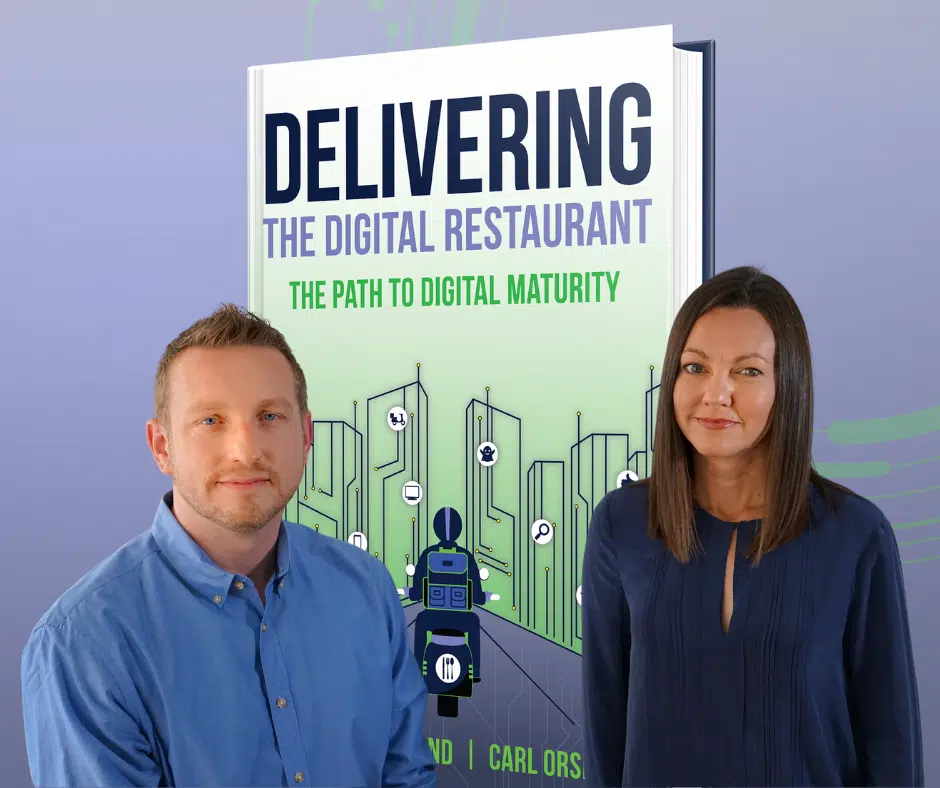
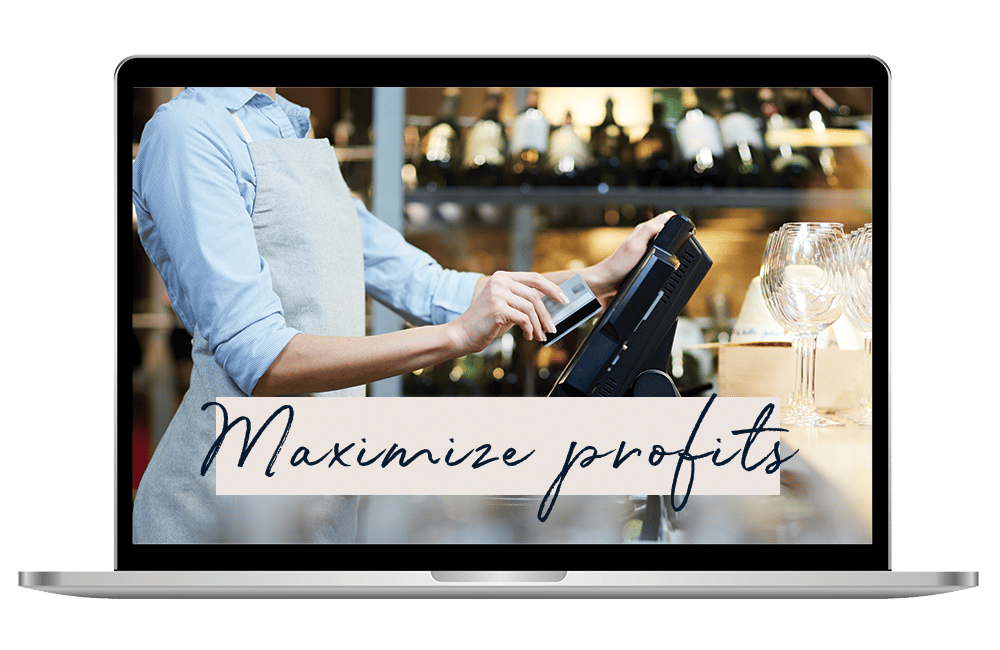
The three costly mistakes you could unknowingly be making?
Find out in this FREE guide and restaurant assessment specifically designed to reveal the unexpected hurdles standing between you and exponential business growth.
Thank You To Our Sponsors
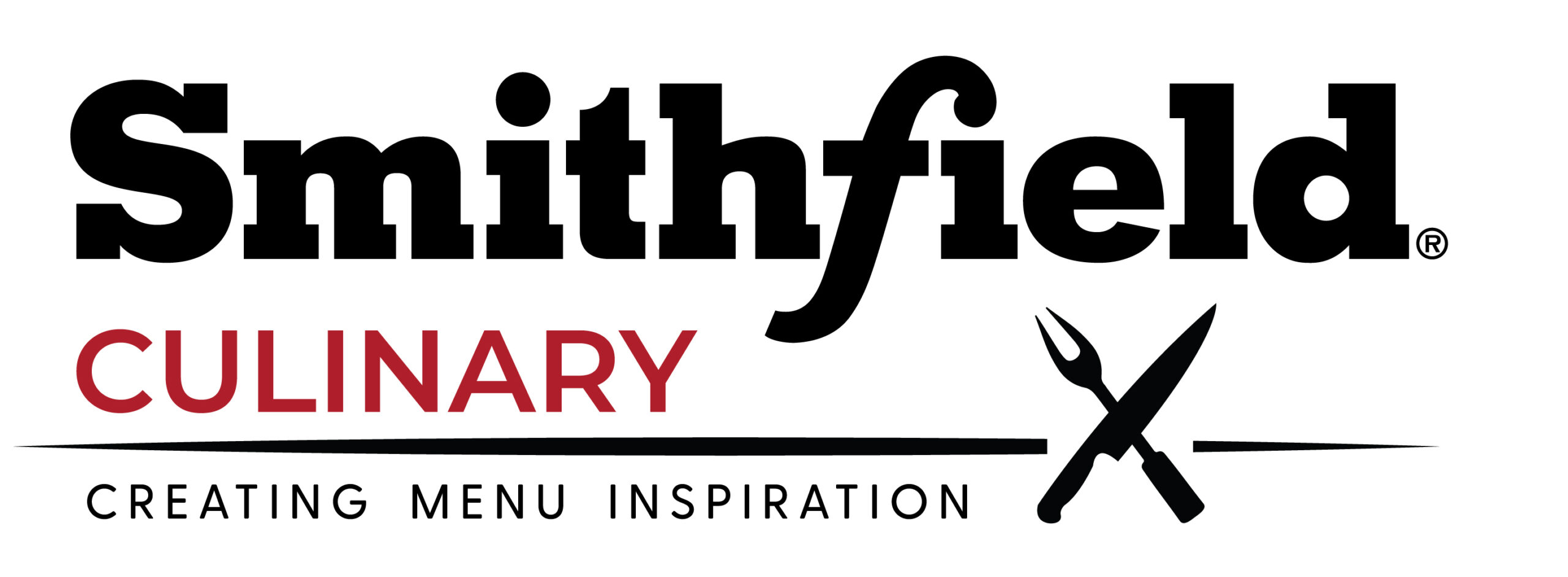
Inspiring Head-Turning Menu Creativity
Culinary Trends & Chef Inspired Recipes - Learn More

The Employee Retention Tax Credit We will help you determine your eligibility for 2020 & 2021 - Get Started
Want to become a podcast sponsor?
Please get in touch with Roger at roger@restaurantrockstars.com
